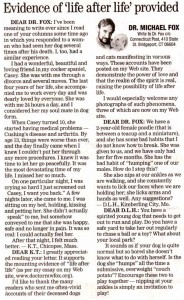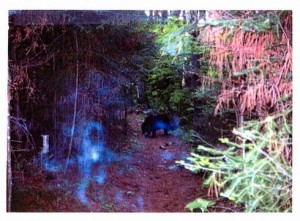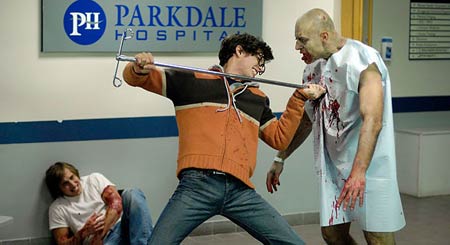Dr. Michael Fox: Photographic “Proof” of Life after Life
February 11, 2009
My favorite goofy veterinarian Dr. Michael Fox, is back with another entry in his ongoing attempts to prove what he calls “life after life” in his nationally syndicated newspaper column titled, Evidence of ‘life after’ provided (2-11-2009).
Once again, the lede is being buried on the crossword puzzle page.
If the editors thought for one moment that Dr. Fox had compelling evidence for the continued existence of personality after a dog’s metabolic processes have ceased, surely this would be on the front page, above the fold. Instead they ran it next to the horoscope and Suduko puzzle.
Don’t get me wrong, Dr. Fox can hold whatever spiritual or religious views he chooses. I simply think that such opinions should not contaminate the offering of his medical expertise as an experienced and knowledgeable veterinarian in the public press.
He’s outside of his skill set here: he is, after all, writing a column of advice to pet owners. It would be just as inappropriate for him to include his opinion about Jewish dog owners, Southern Baptist cat fanciers and Druid parrot keepers.
There are two distinct problems with Dr. Fox’s presentation. One is that all his readers who write in about seeing or somehow sensing their recently deceased pets are grieving. I think Dr. Fox is exploiting that grief, just like alleged psychic John Edward does on TV.
The second is the sketchy photographic proof he provides on his web site, here. The term for what’s going on here is pareidolia, the misperception of something unique and distinct in a vague or ambiguous pattern. Think the Virgin Mary on a piece of toast, Jesus Christ on a burnt tortilla, a pretty horsie in the clouds above.
I’m going to show you Dr. Fox’s evidence. Look carefully at the three images. Later, I’ll tell you what he thinks you should see and you can compare impressions. . .click on the pictures for larger images.
If you don’t independently and without prompting see precisely what Dr. Fox sees, I’m going to call this pareidolia, not evidence.
Picture 1:
Picture 2:
Picture 3:
Instead of encouraging his audience to accept the cycle of life (which ends in death for wonderful dogs, credulous veterinarians and rotten skeptics like me alike), he indulges in wish-fulfillment fantasy. Not only it is unlikely that there will be any freight trains in Heaven*, the matter of canine and cats having souls is also unclear.
In the current instance K.T. of Chicopee, MA considered her cocker spaniel her “soul mate.” The dog Casey, had been with her through a divorce and several moves. When it became necessary to euthanize Casey, she says, “It was the most devastating time of my life. I missed her so much.”
Now, her description of the visitation:
“On one particular night, I was crying so hard I just screamed out, ‘Casey, I want you back.’ A few nights later, she came to me. I was sitting on my bed, holding, kissing and petting her. She didn’t actually ‘speak’ to me, but somehow conveyed to me that she was happy, safe and no longer in pain. It was so real: I could actually feel her.”
K.T. doesn’t explicitly state that she was alone during this encounter, but I suspect she was. If not, I wonder if anyone else present could also see, hold and pet Casey?
I’m suspect of the unfailingly positive messages the deceased animals give their grieving owners.
You never have anyone report that their cat can back and bitched at them, “You stupid tool—it wasn’t a tumor, it was a benign cyst. Dr. Brown is an incompetent old fool! You had me killed for no good reason.” They always tell their owners exactly what they want to hear, even if it is non-verbally.
So there are two possibilities: a grief-stricken, heart-broken person imagines something that comforts them OR spooky ghosts of all dead animals (why should it be limited to dogs and cats?) wander through the night comforting some, annoying others.
How this affects me personally: the cows who were slaughtered for every burger I’ve eaten congregate in my living room nightly, glowing ectoplasmically and try to graze on my rug. For every dish of Kung Pao Chicken, another ghostly clucker scratches my bed looking for phantom seed. Not to mention the pigs from my BLTs! Far better to be a vegetarian and only have to answer to the Spook Carrots and Spirits of Arugula Past.
Dr. Fox’s ‘Extraordinary’ Photographs: His Explanations
Picture 1: “This photo, as well as a video, was taken by the parents of a little girl who was the first to notice the image of her deceased dog in the sky. It looked just like their old Golden retriever, and yet ironically, nobody else at the outdoor school event, except her parents, could make out the image. I slightly enhanced the original photo with a little more contrast.”
Picture 2: “This photo. . . shows an aura or astral body of light around a tree that had been planted in memory of the family dog, whose surviving companion lies beneath. The owner, an experienced photographer, told me that this image was not evident when he took this picture, nor was it evident in pictures that he took just before and immediately after this extraordinary one.”
Picture 3: “Copies from the scratched color print (negative was lost) provided by the owners are reproduced here in contrast color and black and white to reveal the image as clearly as possible in the foreground. This phantom-like image, which they took to be their recently deceased dog, was not evident to them when they were out in the woods walking their other dogs and snapped a photo of one of their dogs further down the trail. The deceased dog’s tail, possibly wagging, and the hind legs can be clearly seen in the foreground, with the dog’s head and ears toward the center of the photograph.”
How close did your guesses come to Dr. Fox’s explanations?
__________________________________________________________
*Jimmy Rodger’s “Hobo’s Meditation”
Will there be any freight trains in Heaven?
Any box cars in which we might hide?
Will there be any tough cops or brakemen
Will they tell us that we cannot ride?
Animals Communicating After Death: The Evidence?
September 25, 2008
BOOK REVIEW: Dog Body, Dog Mind: Exploring Canine Consciousness and Total Well Being by Dr. Michael W. Fox
Dr. Michael Fox has a nationally syndicated column, “Animal Doctor” and is the author of at least 15 books about dogs, cats, pet foods, bioethics, ethology, genetically modified foods, therapeutic touch and massage for animals, among other topics. His bio says that he’s authored over 40 books in total.
His most recent book on dogs is Dog Body, Dog Mind: Exploring Canine Consciousness and Total Well Being (2007). He’s educated, experienced, obviously cares deeply about all animals. There’s a lot of good material in Dog Body, Dog Mind. For solid information on correcting behavioral problems, the existence of emotions and consciousness in dogs, diet and health care this is an excellent reference. I especially liked the final chapter, Chapter 22: In Praise of Mutts, which should be required reading for all members of the purebred dog fancy.
Unfortunately, it is also packed with pseudoscientific claptrap.
It boggles the mind to consider how a deeply intelligent vet can write and, apparently believe, some of the silliness in this book.
In this regard, his book is much more dangerous than some of the outright nonsense written by pet psychics and others on the lunatic fringe of pet care and advice. Those can be dismissed entirely. But Dr. Fox’s work requires more careful dissection.
Let’s take a look at a few chapters from the middle of his book to show precisely what I mean.
Chapter 8: “Psychic” Animals and their Super-Senses
First, and most importantly, I must remind Dr. Fox that the plural of anecdotes is not data. His most outlandish statements are backed by stories he has received from his large audience of readers. There is no attempt by Dr. Fox to make any independent verification of the information he receives (at least none that he sees fit to mention in his book).
If you write to Dr. Fox, your truthfulness and accuracy are never questioned. He accepts your story uncritically even when you make extraordinary claims. And we all know that extraordinary claims require extraordinary proof, don’t we? There are no footnotes or sources listed, just an index. We have to take it on faith that Dr. Fox is accurately reporting what he’s been told and that his correspondents are correct in their interpretation of their experience.
You’ll find this device used over and over again in the chapters under consideration. Example: a woman from Florida writes him about her 55 year old father whom she says had no known major health problems. Her father’s dog displays a new habit of placing a paw on his chest, looking at him “straight in the eyes.” It’s not made clear how long this behavior went on, but sometime later the woman’s father dies in his sleep in the middle of the night. The cause of death is stated as “chronic lung disease.” She concludes that her dad’s dog knew what was wrong with him, while no one else did.
Dr. Fox declares this an instance of the dog’s “prescience.”
For anyone versed in logical fallacies this is clearly a case of retrofitting the conclusion to make surprising what is, after all, a common sort of behavior for a dog. One of my dogs has recently started resting his head on one of my feet. Should I rush to a podiatrist to confirm my Labrador’s obvious diagnosis of impeding bunion trouble?
First, let’s look at this story logically. Do you believe her account that a middle-aged man died of chronic lung disease and showed no symptoms whatsoever prior to his death? I’d say that’s highly unlikely. If he even had shortness of breath, this alone might have drawn his dog closer to him, sensing his distress. Let’s also note that “chronic lung disease” is a vague, catch-all phrase, not a medical diagnosis. Just what exactly did this man die of?
And how does she know that the paw on the chest proves that the dog “knew” of his master’s lung disease? Maybe the dog was actually diagnosing pending heart failure and got the whole thing wrong. Stupid dog.
Here’s another example of retrofitting (or creative interpretation) from earlier in Dr. Fox’s book. He tells the story of two animals who “brought themselves to us for treatment” at the Animal Refuge in South India that he operated for many years in India with wife. They were a dog with a broken back and pelvis and a water buffalo dying from a severe screw worm infestation. “Neither of these animals had ever been near our refuge before, yet somehow they knew it was a place where animals were cared for and healed” (my emphasis). This is a case of counting the hits and ignoring the misses.
Isn’t the explanation much more likely that instead of somehow knowing about this place of healing, these sick and injured animals just happened to wander in their pain and disorientation near the South India Animal Refuge? Ignored in this example are all the other sick animals who wandered around and died of their illnesses or injuries and never got anywhere near any sort of refuge.
Next Dr. Fox relates a few anecdotes about pets separated from their families who find them in places the pets have never been before. He tells of a “documented case” of a cow and a calf sold at auction in England, sent to separate farms. The cow is found the following morning at the farm where her calf is, many miles away. It may be documented, but Dr. Fox fails to provide any way for his readers to check up on that documentation.
Dr. Fox calls this phenomenon “psychic trailing” and cites the work of parapsychologist J. B. Rhine of Duke University. Dr. Fox should’ve done a little research to find out how thoroughly discredited Rhine’s research is before using him as an authority.
But wait, in the next section of this chapter Dr. Fox goes completely off the rails. You’ve got to read this in his own words to see how nonsensical his ideas are:
Simply put, we are all connected psychophysically with the sun, moon, Earth, the stars and with each other through the realms of the senses and the emotions. It is the emotional connection with his owner or family that forms a point in the space-time continuum, that enables the animal to re-orient from his home-base and find his family. I propose that the animal’s internal sun-time clock and geomagnetic compass are used, like a directional feeling-sensitive antenna, once the animal has aligned himself towards the emotional field of its owner/family. This field, which I call the empathosphere, makes the space-time continuum a unified field.
Next he claims that Albert Einstein theorized the existence of this new concept, the empathosphere, but failed to express it mathematically. Stupid Einstein. I’d like to ask Dr. Fox for the precise reference in Einstein’s work that supports this claim. He goes on to state that this existence of this field “in which all things are interconnected and interdependent” has been demonstrated by the “modern sciences of ecology and quantum mechanics.” I must not have gotten that memo.
Now I will admit that my understanding of quantum mechanics is very limited. But I propose that Dr. Fox has no understanding whatsoever of this very complex theory for him to cite it as proving the existence of this “empathosphere” idea of his. Quantum mechanics deals with the strange behavior of sub-atomic particles and does not scale to the realm of ordinary human-sized interactions. QM is falsely cited by many practitioners of New Age and CAM (complimentary and alternative medicine) as offering support for their bogus theories.
Excuse me, I’ve got to brush all these protons off my keyboard before I can continue typing.
Dr. Fox states that we who live in Western industrialized societies have lost touch with these “supra-sensory” powers. He claims these powers were demonstrated by the aboriginal peoples of pre-colonial Australia and used for healing and “living in harmony for health’s sake.” Aside from the vagueness of this last statement, he offers no support for these “supra-sensory” powers. Citations, Dr. Fox?
Chapter 9: Entering the Deep Heart’s Core: The Empathosphere
“When it comes to evaluating animal prescience and remote sensing—what is commonly regarded as psychic communication or clairvoyance—an open mind is called for. Let the facts speak for themselves. . .”
I agree absolutely with Dr. Fox on this point. He is quite right. Unfortunately, the chapter that follows these introductory lines contains not a single fact, just “my own observations and the anecdotal data of others.”
Again, not to nitpick but let’s be clear that anecdotes are just that, and not data. In science there is no such animal as “anecdotal data.” There are thirteen unverified accounts sent to him by readers. Some of them are wonderful, deeply emotional stories, but they are not the facts that should be speaking for themselves.
Still Dr. Fox believes that these stories lay “the groundwork for launching into the next chapter, which explores the profound realm of animals’ ‘extraterrestrial’ or afterlife communication and manifestation from beyond the grave. . .” Cue the spooky organ music.
Chapter 10: Animals Communicating After Death: The Evidence
Now just suppose that dead animals could communicate and even manifest themselves physically (or, according to Theosophists, as an etheric double or astral body) to their human companions still living on the plane but grieving their departure terribly: What if this communication and manifestation could be verified? Would this not upset the apple cart of the nihilists, rational materialists, and those who think only humans have immortal soles and are special? The impact would be as profound as would the arrival of intelligent life-forms visiting us from outer space.
You’re darn right it would, Dr. Fox. I’d also think you’d be a strong candidate for a Nobel Prize or a MacArthur “Genius” grant (or at least a slimed copy of the Ghostbusters DVD). Ah, but here’s that old caveat: “. . .the following letters provide irrefutable proof” (my emphasis).
If you really had irrefutable proof, Dr. Fox, instead of 17 letters from grieving pet owners telling of various manifestations* your book would have been the publishing event of 2007, you’d be besieged with interview requests from the major media and a host of scientists and skeptics would be clamoring to review your evidence for themselves.
Dr. Fox, you could’ve been on Oprah!
And talk about burying the lead! You’ve got “irrefutable proof” of the existence of consciousness and personality after death (even just for canines) and you put it in Chapter 10 of a 22 chapter book? I have to conclude that Dr. Fox is either not serious about this momentous claim or he understands perfectly well that what he presents does not rise anywhere near the level of “irrefutable proof.”
Back in the prehistory of the 1970s there was a magazine published by pornographer Bob Guccione called OMNI which mingled science fact with science fiction. I had a friend who hated this combination on the grounds that the presence of the fiction polluted the facts. As many hard science fans are also into sci-fi I thought his position was a little extreme. At least the fiction was labeled as such. But in Dog Body, Dog Mind there are no disclaimers and outright nonsense is mixed right in with solid scientific information. By doing so, Dr. Fox does a great disservice to his readers, many of whom will unquestioningly swallow this mixture whole.
*And one photo of a dog with a semi-transparent patch of white above it that Fox concludes is a manifestation of “a fine, amorphous energy field of light, that could be one of the ways by which deceased animals may communicate to the living.” Obviously, Dr. Fox has never read any of Joe Nickell’s excellent work on photographic frauds and misinterpretations.
NOTE: A copy of this review has been emailed to Dr. Fox for his response. If he replies, I will append his comments to the review.
9/26/08: Dr. Fox has responded. Here is what he wrote (in total) “Joseph—you need a good dog. michael.”
I’d like to point out that this is, in effect, an ad hominem attack. He does not address even a single point I raised and assumes that my problem is, I don’t have a “good dog.”
It is the equivalent of telling a feminist you disagree with that what she needs is “a good. . .uh, man.”
Dr. Fox, I have two wonderful Labradors and have also been involved in breed rescue groups and at my local shelter. My wife and I are responsible for saving the lives of 40 dogs over the past 5 years, fostering 23 of them in our home. This is, obviously, just a drop in the bucket given the pet over population problem in America today but, hey, we all do what we can.
It is not my lack of “a good dog” that is at issue here. It is the quality (and the truthfulness) of his thinking and beliefs that I have a problem with.
Dogs are amazing creatures and worthy of our respect and admiration without tarting them up with silly metaphysics, psychic abilities and ‘beyond the grave’ manifestations.
Have you heard about the Zombie Dogs?
February 1, 2008
Science marches on. What would you think of a process that drains the blood from your dog, replaces it with an artificial fluid, then returns the blood and has that same dog fetch some brains for you?
The Zombie Dogs of Pittsburgh. It sounds ghoulish or like someone’s idea of a sick joke, especially given that this is the hometown of George Romero, whose most recent film was Land of the Dead. But the Zombie Dogs are real. Sort of.
“It’s so unfair and so bizarre,” Dr. Patrick Kochane, of the Safar Center for Resuscitation Research in Pittsburgh said. “Somebody must have thought the title ‘zombie dog’ would be a catchy phrase.” But the researcher adds, “That is the farthest thing from what we are doing.” It sounds like a complete denial that science is crossing the line into the unholy Black Arts and seeking to create an army of unstoppable canine zombie warriors. Cool as that might be. . .
The point is to save human beings who have suffered cardiac arrest or massive blood loss. As they have for centuries medical science has turned to the dog for experimentation. We get to do this since we are King of the Jungle. The calculation has always been that if a few dogs die helping conquer human disease, this is a price we’re willing to have dogs pay for us.
Given that some 4 million cats and dogs a year are euthanized in the US and their deaths don’t assist our research at all. (But some of them come back as pet food).
It works out that a cat or dog is put to death every 8 seconds in our animal shelters. The cost of this is around $1 billion dollars a year, (and you know that Animal Control Officers are never the highest paid municipal employees).
We’re actually doing a lot better these days, in the new millennium and some 10 years or so after the rise of “Dog Culture.” In the 1970s it is estimated that the kill rate was 13.5 million a year. And we had to listen to disco music, too.
The figures from 2006 are that there are 50 million US households that have a total of 73 million dogs in them. Proof that we live in a cruel and indifferent universe, there also are 90 million ‘owned cats.’
From the dog’s perspective, let’s consider what’s called ‘clinical death.’ Your heart stops beating, you stop breathing and all brain activity ceases. That’s what these Zombie Dogs were revived from, clinical death. Creepy, right? The 24 dogs in this experiment had their circulatory systems flushed with an ice-cold salt solution that would bring their core body temperatures down to 50 degrees from a normal 102 degrees.
Our Zombie Dogs were in a state of suspended-animation (just like Buck Rodgers). The difference being that if you are revived intact, it was suspended-animation. If not, it’s just an extra salty clinical death.
The big news out of the Safar Center for Resuscitation Research in Pittsburgh was that they had set a new duration record: 3 hours! They achieved this by adding tiny amounts of glucose and dissolved oxygen to the cold saline solution. They were revived by pumping warm blood back into their bodies and giving them a small electric shock. Told of the findings, Keith Richards expressed immediate interest.
The report says the dogs emerged without brain injury. So these dogs were clinically dead for three hours and came back. . .normal. Not hungry for brains, for instance.
The goal is to get this procedure to a stage where it can be tried on humans, as a way of stabilizing someone who’s seriously injured so doctors can, for example, locate bleeding sites and repair them. Suspended animation for even a short duration would have a major impact. Thus, people who before would have bled to death before medical intervention could take place would now have a much greater chance of survival. Then they’ll have to put up with a lot of Zombie-related ribbing.
George A. Romero’s fifth entry in his zombie series, Diary of the Dead opened on Feb. 15, 2008. Click here for the New York Times review.
It’s a good time to be a fan of zombies.
Zombies are making a huge come back these days in films and popular culture. People go on organized Zombie Walks. Max Brooks’ two books The Zombie Survival Guide and World War Z strike just the right tone and are darkly hilarious. Max was a writer for Saturday Night Live and is the son of Mel Brooks and Anne Bancroft. If you haven’t read ’em, buy ’em today! Tell them necessity sent ya’. World War Z has been optioned for the movies and should be filmed like a Ric Burns’ documentary. The straighter this material is handled, the better.
The Zombie costume is now featured along side your Freddy Krueger’s, your Frankenstein’s monster, your Sexy Witch in all the Halloween catalogs. There’s a great comic book about zombies being published by Image, The Walking Dead.
Of course, Pittsburgh’s George Romero will always be known as the creator of the modern-day zombie conventions. You really do have to overlook the skilion or so low-budget zombie horror exploitation flicks. Zombies are among the cheapest monster effects in film, so it makes sense that this theme would be exploited by filmmakers with limited budgets. There are only a handful of ‘straight’ zombie pictures that are worth your time. The four Romero films, certainly: Night of the Living Dead, Dawn of the Dead, Day of the Dead and Land of the Dead.
You’ll get some nit-picking over details (fast moving zombies vs. their classic shuffling walk or the victims of rage plague vs. the truly undead) but I would include 28 Days Later, the remake of Dawn of the Dead in 2004 by Zack Snyder, the Resident Evil series with the incomparable Milla Jovovoch and Carnival of Souls on the list. This last one will send the fan boys over the edge.
There really aren’t zombies in COS, just the undead who keep popping in for inopportune visits, though they do fit under the low-budget make-up rule. The actors playing the ‘souls’ wear little more than white pancake make-up to indicate their status. And they are in constant pursuit of the heroine, a beautiful blonde church organist. At one point in the film she plays some ‘unholy music’ (could it have been Ina Gadda Da Vida by Iron Butterfly? No, that was a Simpson’s episode: “Hey Marge, remember when we used to make out to this hymn?” ).
Afterwards, she is remonstrated by a priest.
There’s also a distinction between stories where animals can be affected, as with Resident Evil’s undead dobermans and crows and zombie worlds where only humans are involved like the excellent comic book series The Walking Dead, written by Robert Kirkman.
The reason I find a good zombie film satisfying is probably part of the same paranoid thinking that leads me to identify with all the screen versions of Invasion of the Body Snatchers and The Thing (from Outer Space). Because in my own delusional way, this is how I see the world. There are a (very) few awake and thinking people, who need to band together for protection, surrounded by an ocean of soulless consumers and sheep who want to make us behave just like them. And in a zombie film the ‘monster’ is everyone around you; neighbors, family, strangers from two towns over. This also seems to be the case in the alleged ‘Real World.’ We echo Dr. Kochane here: “It’s so unfair and so bizarre.”
Source: “Pitt scientists resurrect hope of cheating death” by Jennifer Bails
PITTSBURGH TRIBUNE-REVIEW, Wednesday, June 29, 2005






